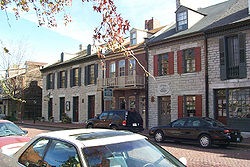St. Charles, MO
| St. Charles, Missouri | |
|---|---|

Historic Main Street
|
|
 Location in the state of Missouri |
|
| Country | United States |
| State | Missouri |
| County | St. Charles |
| Government | |
| • Mayor | Sally Faith |
| Area | |
| • Total | 24.03 sq mi (62.24 km2) |
| • Land | 23.65 sq mi (61.25 km2) |
| • Water | 0.38 sq mi (0.98 km2) |
| Population (2010) | |
| • Total | 65,794 |
| • Estimate (2016) | 69,293 |
| • Density | 2,700/sq mi (1,100/km2) |
| Time zone | CST (UTC-6) |
| • Summer (DST) | CDT (UTC-5) |
| Area code(s) | 636, 314 |
| Website | www |
St. Charles is a city in, and the county seat of, St. Charles County, Missouri, United States. The population was 65,794 at the 2010 census, making St. Charles the ninth-largest city in Missouri. It lies to the northwest, and is a suburb of St. Louis, Missouri on the Missouri River.
Founded in about 1769 as Les Petites Côtes, or "The Little Hills" in French, by Louis Blanchette, a French-Canadian fur trader, when the area was nominally ruled by Spain following the Seven Years' War, it is the third-oldest city in Missouri. For a time, it played a significant role in the United States' westward expansion.
It was settled primarily by French-speaking colonists from Canada in its early days and was considered the last "civilized" stop by the Lewis and Clark Expedition in 1804, which was exploring the western territory after the United States made the Louisiana Purchase. The city served as the first Missouri capital from 1821 to 1826, and is the site of the Saint Rose Philippine Duchesne shrine.
Native American peoples inhabited the area since at least 13,000 years before the present. When the Europeans arrived the area was inhabited by the Ilini, Osage and Missouri nations.
According to Hopewell's Romantic Legends of the Missouri and Mississippi: Blanchette met another French Canadian (Bernard Guillet) at the site of St. Charles in 1765. Blanchette, determined to settle there, asked if Guillet, who had become a chief of a Dakota tribe, had chosen a name for it.
Blanchette settled there in about 1769 under the authority of the Spanish governor of Upper Louisiana (the area had been ceded by France to Spain under an agreement with Great Britain following French defeat in the French and Indian Wars). He was appointed as the territory's civil and military leader, serving until his death in 1793. Although the settlement was under Spanish jurisdiction, the settlers were primarily Native American and French Canadians who had migrated from northern territories.
...
Wikipedia
